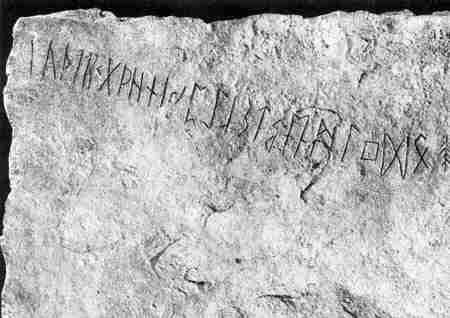 |
|
the Gokturk alphabet |
The Kylver stone from Stanga (Gotland) SWEDEN | The Mojbro stone from Uppland SWEDEN | The Istaby stone from Blekinge SWEDEN |
| The Futhark alphabet was used by the North
European Germanic peoples (the Swedish, Norwegian and Danish) between the
3rd and 17th centuries A.D. About 3500 stone monuments in Europe, concentrated
mostly in Sweden and Norway, are claimed to have been inscribed with this
writing.
This Futhark alphabet, which is also called the Runic stemmed from
the very same origin as did the ancient Turkish inscriptions with
the Gokturk alphabet.
There is a claim is that the alphabets of these monuments found in
both Europe and the Central Asia have stemmed from a common origin in a
very remote past. Then, it was only a natural development for the Turkish,
and the Germanic tribes that, although in locations so far away from each
other, they could seperately carry on with this heritage of writing.
|
|
The Orhun monuments were discovered by a Swedish officer named Strahlenberg, and his finding was made known by publications in 1730. In 1893, the Danish scholar Thomsen was able to decipher these inscriptions and declare that they were written in Turkish .The monuments of Kultigin and Bilge Kagan, situated near the Kosho-Tsaydam lake in the Orhun River valley to the south of the Lake Baykal, and that of Sage Tonyukuk, the Deputy-Khan a little farther, are the three important memorials which make up what is known in general as the Orhun Monuments. The inscription used on them consists 38 characters. Numerous stone monuments are also found around the Yenisei River, but they belong to a period much earlier than that of the Orhun pieces, and there are in excess of 150 Skyturkish character-forms used on. The ancient Turkish script was written vertically with the lines running from top left downwards to the bottom right, and read accordingly, that is from right to left when the text is laid down on its right side. The individual marks are not joined, and the full or partial sentences are seperated with a column mark " : " in between. The eight vowel sounds of Turkish, are represented in couples by 4 marks, and they usually are not employed in the beginning and the middle syllables of a word, but are shown in the last syllable, or if they occur at the end. For example: a ferocious bull, or a fire-breathing dragon . The "god", or "a deity". As for the Futhark alphabet employed on the stones found in Sweden,
the monuments bearing this inscription are studied in
a) The oldest runic inscriptions b) The 16-rune Futhark and Runic inscriptions from the Viking Age. The oldest runic inscriptions are written with an alphabet of 24
characters .\
- The stone from Kylver farm in Stanga (Gotland). This is the oldest
relic found in Sweden, dating back to the fifth century.
- The Mojbro stone from Uppland. - The Istaby stone from Blekinge.
|
| Although these three monuments are declared
as not deciphered yet, the author is attempting at some unfounded assumptions
in relation to their contents. According to the map supplied at the end
of this book, there happens to be numerous stones, which
are inscribed with the same alphabet and belong to the same period of history, in more than 70 locations in the north and northwest of Europe. The monuments considered to be in the 16-rune futhark group belong to a later period called the Viking Age which started at about AD. 800. During this period, the 24-characters of the Primitive Norse runes became simplified and reduced to 16-rune series.The pages 25-30 and the rest of the book in Jansson's study are allocated to this subject. The Europen scholars have come to recognize from the very beginning
the obvious similarity between the character forms of the Primitive Norse
stones and those of the C.Asian Gokturk monuments, but for certain various
reasons have refrained from
It must be kept in mind that the ancient Turkish script used in Central
Asia and the Primitive Norse futhark in Europe, as well as those other
scripts mentioned in passing above, have all stemmed from a common origin
in a very remote past. Then, the Turkish, Germanic, and other tribes have
independently relied on this common
|
|
|
 |
The stone from Kylver farm in Stanga (Gotland) .
Now, we can take a closer look at the photograph supplied on page
13 in Prof. Jansson's book: The whole Primitive Norse rune-row is recorded
on a stone, used as a side-slab in a sarcophagus, and found in Kylver farm
in Gotland.
 |
Since the characters from the 1st to the 6th spell out futhark, this
word is used to denote the runic script. However, some characters are cut
slightly different on the stone than what is shown within the text above:
 |
An identical form of the futhark character shown under #23 is also
found in the Tonyukuk inscription, although it is not given in the
main list of symbols. It is stated to mean "head". But it could also signify
k+l. kel kelle, which is a synonim for the same word, and a composite form
of these two distinct characters.
The same thing can be said for the character #13: It is a composite
form of the symbols
meaning (to) talk, (to) speak in English. It is also interesting
if we consider the form as a pictoglyph of an open mouth.
Now, we shall venture to read this 24-character rune row, from right
to left, by applying the rules of reading Gokturk inscriptions:
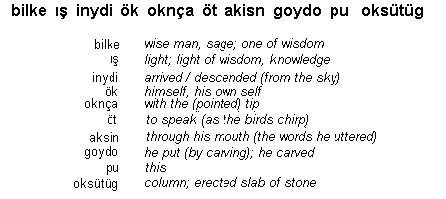 |
The meaning obtained thru reading the above piece, as if it were
written in ancient Turkish, can roughly be rendered in today's English
as follows:
 |
The light of wisdom arrived/descended, he himself carved onto this
erect stone, with ( the pointed tip of ) his
arrow/dagger, the words he uttered/spoke through his own mouth.
We will refrain from venturing into any philological or philosophical
interpretations here. But, please draw your attention to the emergence
of the word O.d.ng, when the characters numbered 24, 23, 22 are considered
in their runic namesakes. In the Scandinavian mythology, it was Odin, the
Norse God who brought the gift of divine script to mankind. Then, the very
name of the god in these three symbols read out as the light of wisdom
(alias the divine reason), or the sage/lord of light in ancient Turkish..
|
|
 |
The Mojbro stone from Uppland, which is a memorial
monument:
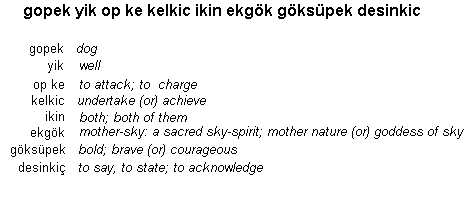 |
In this script, our attention is drawn to the placement of some characters backwards. Especially, the rune R, read as "op", is peculiar. For this reason, it has been read as "po". Reading from right to left, starting with the bottom line:
The meaning obtained thru reading the above piece, as if it were written in ancient Turkish, can roughly be rendered in today's English as follows:
(May both of) the dog(s) charge well; so that the sacred sky-spirit
acknowledges their boldness..
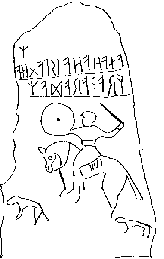 |
On this stone, under the inscription, there is a carving of a rider on his horse, holding up a round shield in his left hand while brandishing his weapon in his right. There are two dogs running beside the horse, as if all of them are engaged in an attack.
Also, the writing style of the symbols and the density of symbols,
means the less character spacing, on the left corner, proves the original
writing style was from right to left.
|
|
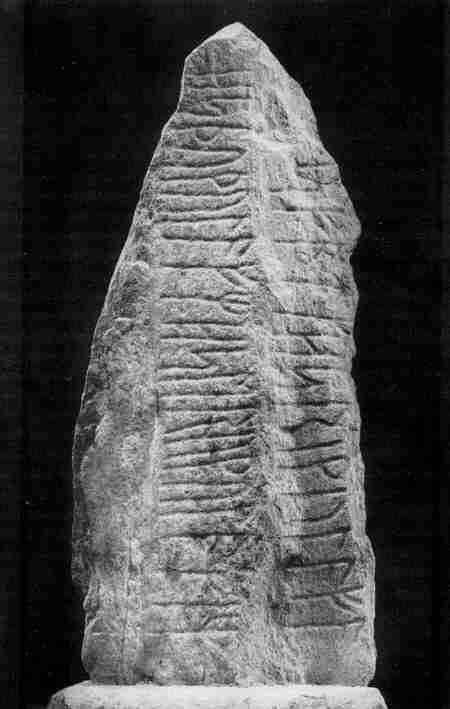 |
The Istaby stone from Blekinge, which was carved in
the transition period between the Primitive Norse period and Viking Age:
 |
Reading the inscription from right to left:
 |
he (who was) brave (and) lived through many hardships (of) army,
committed not flight (or did not desert his post of
duty) lies herein...
Truly a fitting epitaph for a soul who endured much in his wordly life.
These three stones are supplied within the chapter titled "The Oldest
Runic Inscriptions" in Prof. Jansson's book.
There maybe some minor mistakes and errors in the treatment of the
subject. However, there is the opinion held that these stones do
contain the messages of similar meanings in more or less the same way as
I have striven to put forward.
The purpose is to initiate a new interest in this ancient inscriptions
and be of help in starting up a fresh discussion in regard to their contents.
The Primitive Norse futhark or the rune alphabet have stemmed from
a much older common origin as that of the Gokturks.
 |
 |